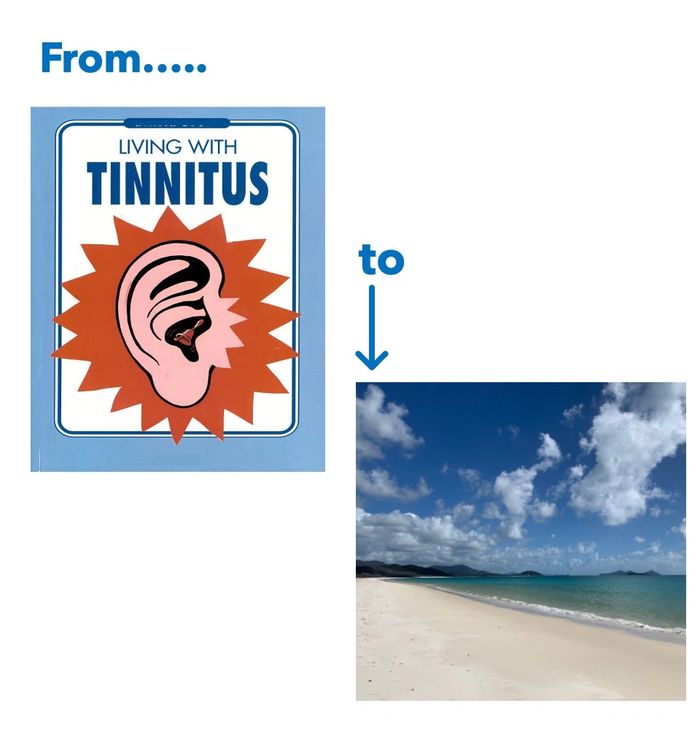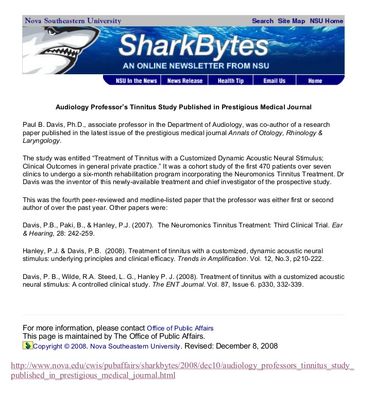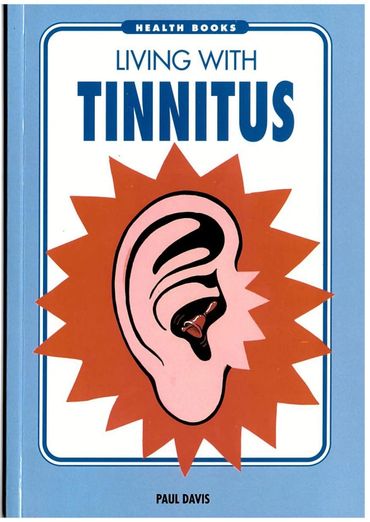

About Tinnitus TeleCare
Tinnitus Telecare can help in profound ways!
We are a recognised Centre of Excellence, with award-winning Doctoral-level Audiology Specialists providing evidence-based & compassionate clinical care.
TEST YOUR TINNITUS!
Tinnitus can vary widely in severity and have a unique combination of effects on you. For some people, sleep is the biggest problem; for others, it is concentration, relaxation, hearing difficulties, etc. One of the most well-regarded ways to measure the effect of tinnitus is the use of the Tinnitus Functional Index questionnaire. It is the best way to find which aspects of the tinnitus experience need addressing first. It is also an excellent repeat measure for pre/mid/post-therapy evaluations.
TESTING YOUR TINNITUS
We now offer a free service where you can complete this evaluation online. You follow the link below to access the questionnaire, where you fill in your details and the usual privacy agreements and then follow the prompts to rate the effects of your tinnitus across 25 separate domains. An Audiologist will interpret and score the results and email the outcome back to you. It typically takes 24-48 hours. You are welcome to make other submissions later to see if your test results are stable or not.
About Tinnitus TeleCare

Our Mission
At Tinnitus TeleCare, our mission is to improve the lives of those with Tinnitus, Hearing Loss & Hyperacusis

Our Team Leader
Dr Paul Davis has specialised in tinnitus for more than thirty years. Bio is here;
https://www.linkedin.com/in/paul-b-davis-phd-8944a85a
Please contact us to arrange in-person care in Perth, Adelaide, Melbourne, Sydney, Brisbane, Bangalow, and the Sunshine Coast.

Our Services
We offer both TeleHealth and in-person consultations at our clinic in Bangalow.
We have a rare (but essential) ultra-high-frequency audiometer and so measure hearing up to 20,000 Hz. We do tinnitus tests of pitch match, loudness balance, minimum masking level, and loudness discomfort levels, right across the full range of human hearing.
We offer Tinnitus Assessments, Counselling (incl CBT), & Hearing Aids. We provide all the regular Audiology services too, such as middle ear testing, workover, musicians earplugs/monitors etc.
We also can dispense the DVA-contracted Neuromonics Tinnitus Treatment, and its exciting new successor called Oritone Tinnitus Therapy (Previously known as Brainwave TRx).
Brainwave Tinnitus Treatment

WHAT IT IS
Oritone Tinnitus Therapy is a customised sound stimulation for tinnitus, based on computational neuroscience principles. Using patented algorithms, it delivers highly broadband 4D ocean wave stimuli (up to 16,000 Hz), designed to modulate neural activity associated with tinnitus. It previuously was known as Brainwave TRx. It has recently become available through accredited audiologists around Australia. Clinical evidence shows rapid, substantial reductions in tinnitus disturbance and improvements in sound tolerance.
Why Tinnitus Persists
Tinnitus significantly affects over 6% of people, particularly those with noise exposure, such as veterans. Damage along the auditory pathway unmasks internal “brain static,” leading to sleep, concentration, and sound-tolerance issues. MEG studies indicate that tinnitus annoyance stems from compensatory gain in the auditory system, which amplifies phantom sound perception. Previous approaches, like Neuromonics, used tailored audio to restore cortical coding. Oritone represents the next-generation refinement, developed over 30 years of clinical research.
HOW IT WORKS
Inputs: full audiological profile (250–16,000 Hz) including thresholds, loudness discomfort, masking levels, and tinnitus pitch/loudness.
Processing: a 42-step algorithm transforms water sound recordings into dynamic 4D wave trains, customised to each hearing profile.
Outputs: softer-level stimuli providing immediate relief and long-term neuroplastic change, reducing awareness and disturbance.
DELIVERY AND USE
The therapy is delivered via iPhone/iPad (iOS 18+) with AirPods 3, 4, or Pro 2 or Pro 3, which scan the ear to calibrate high-frequency response. Patients typically use ≥2 hours/day at peak annoyance times, without fully masking tinnitus, to encourage adaptive interaction. Only accredited audiologists may dispense it, with structured follow-ups over six months.
CANDIDACY
About 73% of patients in private practice are suitable. Exclusions include moderate–severe hearing loss, fluctuating thresholds, or significant depression. Those with marked sound-tolerance issues are often strong candidates. Cases of profound hearing loss are better served with hearing aids or cochlear implants.
EVIDENCE TO DATE
Clinical tests show customised stimuli lowered masking needs by 8 dB versus uncustomised sound (perceptually halving loudness). Across 53 patients, over 75% improved by≥5 dB in sound tolerance and perceptibility, and >80% reported a≥40% reduction in awareness and disturbance by four months. In the cohort using the latest algorithms (n=28), mean TFI scores dropped from severe (62) to very mild (29.6) in four months, with continued improvements through one year. Objective measures revealed significant improvements in minimum masking levels, sound tolerance, and tinnitus loudness, accompanied by unique downward pitch shifts that were often perceived as more tolerable.
PATIENT SNAPSHOTS
#NL: TFI 40.8 → 9.2 over 12 months; awareness 80% → 20%; maintenance at ~1 hr/day.
#BR: Annoyance dropped from 50% to 10% in six months; strong gains across audiometric indices.
#WP: Long-standing tinnitus improved after 10 months, with perception shifting “to the back of my mind.”
COMPARATIVE CONTEXT
Oritone compares favorably with other interventions:
- CBT improves coping but does not directly address neural drivers.
- Hearing aids help if tinnitus lies within their bandwidth, but many cases are higher pitched.
- Tinnitus Retraining Therapy is slower and more costly.
- Lenire (bimodal stimulation) has a crude sound stimuli and shows smaller effect sizes.
PATIENT IMPRESSIONS
Users commonly report reduced annoyance, calmer mood, improved sleep, and renewed ability to enjoy activities. The soundscapes are described as softer, clearer, and immersive, enabling long sessions without discomfort. Families note a better mood and quality of life.
PRACTICAL TIPS
Patients are advised to begin at low volume, use during peak annoyance and before sleep, and continue maintenance even when symptoms are minimal to reinforce long-term gains.
BOTTOM LINE
Oritone offers a fast, consistent reduction in tinnitus intrusiveness and improved sound tolerance. Both objective and subjective data suggest effective neuromodulation of auditory pathways. Larger peer-reviewed and ranomised/controled clinical trials are planned, but current clinical outcomes already indicate strong benefits for most patients, often resulting in a shift from severe to very mild symptoms within four months.
MORE INFORMATION AVAILABLE
A whitepaper, which gives far more complete information and evidence, is available via the link below
Brainwave Tinnitus Treatment Data
Oritone tinnitus therapy clinical Data whitepaper
The headline datapoint is that the average improvement in the Tinnitus Functional Index score went from a Severe range down to Mild in just four months. Loudness Discomfort Level Thresholds also went from highly reduced to normal over 4 months of Oritone treatment. A lot more data is available, along with details on the technology. For more information, please request a free copy of the layperson-friendly whitepaper.
Oritone Tinnitus Therapy
Bookings at Bangalow Wellness Hub
Your pathway to overcome tinnitus
How We Assess, Triage, and Treat Tinnitus
Welcome to Tinnitus TeleCare
What is tinnitus?
neurology of tinnitus
effects of tinnitus
Many people assume tinnitus is limited to the perception of a ringing noise in the ears. However, tinnitus can be so many other sounds, such as whistling, buzzing, humming, whirring, cicadas, crickets, and even musical phrases. Tinnitus is the name given to the perception of any noises in the ear(s) and in the head with no external source. In the past it was often thought that ‘nothing can be done for tinnitus’, but in recent years a lot of scientific research has shown that several approaches can help treat tinnitus, albeit gradually.
effects of tinnitus
neurology of tinnitus
effects of tinnitus
All of us experience tinnitus occasionally. However, it can become a problem when this noise persists and/or increases. Several factors can cause the severity of tinnitus to range anywhere from being very disturbing to a state that is not at all intrusive.
People with problematic tinnitus may experience:
• Sleeping problems and resultant fatigue
• Stress, annoyance, irritation, anxiety
• Despair, frustration, depression
These factors resulting from tinnitus can in turn aggravate tinnitus and so a ‘tinnitus cycle’ can be created.
neurology of tinnitus
neurology of tinnitus
neurology of tinnitus
Tinnitus is not a specific disease or an illness. It is a symptom generated within a person's auditory pathways. Recent brain imaging studies have found that tinnitus can be caused by any type of damage to the auditory system that causes hearing loss. This hearing loss can sometimes be very mild or outside the speech range, but it can be enough to ‘uncover’ the brain’s normal ‘static’ noise. When people have normal hearing, the outside sounds are loud enough to mask the brain’s static. With hearing loss, the outside sounds are no longer loud enough to mask this static, so it becomes more apparent, especially at quiet times. This is like the static heard on FM radio when there is no reception.
hearing loss
contributing factors
neurology of tinnitus
Research has found that hearing loss can trigger an auditory deprivation effect, whereby the brain is essentially ‘staving for sound’, so it automatically tries to compensate for that lack of input by turning up the sensitivity to the ear. Unfortunately, it also turns up the perception of tinnitus, and this can often also produce decreased sound tolerance. Tinnitus treatments are most effective when they directly reverse that process.
contributing factors
contributing factors
contributing factors
Factors that may result in or contribute to tinnitus include (but not limited to):
• Hearing loss – particularly noise-induced, but also age-related or other
• Certain medications (such as large doses of aspirin, arthritis medication etc.)
• Head, neck, or ear injuries
• Conditions of the ear such as infections, Meniere’s disease or acoustic neuroma (rare)
• Compacted ear wax
• Jaw joint (temporomandibular joint) dysfunction (rare)e.
lifestyle
contributing factors
contributing factors
Lifestyle factors that may aggravate tinnitus include loud noise exposure, excessive caffeine, stress, depression, and fatigue.
However, as it is the adaptiveness of the brain that can cause tinnitus to be disturbing, this process can also now be reversed to help reduce the intrusiveness, and so ‘treat’ the condition.
WHAT CAN BE DONE ABOUT TINNITUS?
WHAT CAN BE DONE ABOUT TINNITUS?
WHAT CAN BE DONE ABOUT TINNITUS?
There is no ‘magical cure’ for tinnitus yet unless it is related to an easily reversed cause such as ear wax build-up or middle ear pathology. The TGA (Therapeutic Goods Administration) has never approved a medication for tinnitus. However, there are several ways to treat it effectively or to at least minimise the impact that tinnitus has on your life.
Strategies
WHAT CAN BE DONE ABOUT TINNITUS?
WHAT CAN BE DONE ABOUT TINNITUS?
Tinnitus treatment strategies include Hearing Aids (specially programmed), Neuromonics, BrainWave Tinnitus Treatment, Counselling, Auditory Distractions, Stress Management, Hearing Protection, etc. Occasionally, a referral to an Ear, Nose, and Throat Surgeon is indicated when there is potential for a surgical or pharmaceutical treatment.
Evidence from research shows that the most effective treatments tend to simultaneously address the audiological, emotional and neurological components of tinnitus distress. Just focusing on one of those three aspects tends to be less consistently effective.
Evidence-based
WHAT CAN BE DONE ABOUT TINNITUS?
Evidence-based
Tinnitus Telecare has long championed the cause of evidence-based tinnitus treatments. We have campaigned for journal articles to publish effect size calculations, demonstrating how consistently effective the technique was. We have conducted several meta-analyses that compare the effect sizes of various techniques. We will publish regular videos on our YouTube channel outlining the pros/cons of the various tinnitus management or treatment techniques.
Photo Gallery





Contact Us
Tinnitus telecare
Tinnitus TeleCare is at The Bangalow Wellness Hub on Mondays and Wednesdays.
Telehealth sessions (including overseas) are also available on other days by appointment
Bangalow wellness hub
96 Byron Street, Bangalow New South Wales 2479, Australia
Hours
Today | Closed |
Subscribe
Sign up for more in-depth information, and so we can notify you when new content is available
This website uses cookies.
We use cookies to analyze website traffic and optimize your website experience. By accepting our use of cookies, your data will be aggregated with all other user data.